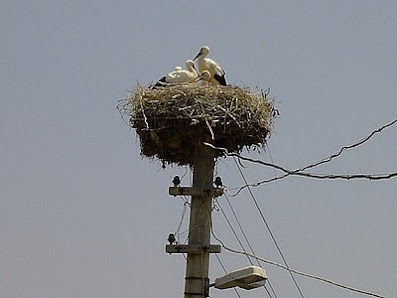Michael - Alternate Thursdays
I've just made the twenty-four hour trip from Johannesburg to Minneapolis and currently my mind is having difficulty with ordinary issues like eating and sleeping. Is it 3am or 11am or...? So forgive me if I delve into the past and offer a redux of a blog about other matters of perception...
I thought a break from the doom and gloom of mankind’s impact on the world might be a nice change before we get back to reality. I'm lucky to have the chance to enjoy the African bush from a bungalow at Olifants River Game Reserve. There is only one thing I dislike about the game reserve area: a railway line runs through the middle of it, and a line of huge high tension electricity pylons march along it across the landscape. This intrusion spoils the atmosphere for me and I’m relieved once I’m far enough away that I can no longer see them and I can pretend again that the area is completely without the blemish of man’s involvement.
The thing is that this is all a matter of perception. We divide the natural from the man-made and make value judgements about the aesthetic value of each of them. The wildlife does nothing of the sort. Of course, some things are inimical to them and they may or may not realize that. (Sadly, we have a few animals killed by the train each year.) But if the objects are not actively dangerous, they just become part of the “natural” environment and are used or simply ignored.
As an example, the brown snake eagle needs a high point from which to spot snakes and other delectable edibles moving about on the ground. A high tree is good, but often the canopy obscures the view and the highest point may be insufficiently strong or stable. So here is the perfect answer:
 |
| Brown snake eagle viewpoint Photo Inga Page |
 |
| Red-billed buffalo weaver. Photo: Nick Borrow |
If there are no wonderfully high pylons about, a normal electricity pole will have to do. At least we get a better view of the magnificent bird:
 |
| A lower snake eagle. Photo: Marga Erich |
Baboons feel the same way. The pylons make excellent bedrooms. Well off the ground, good view all around, and even barbed wire around the base of the poles. (This is there to keep humans from doing anything stupid like climbing the poles, but it also deters leopards who would have no difficult picking a baboon or two out of a nice comfortable tree.)
 |
| Good place for the night. Photo: Aron Frankental |
Houses can be pretty useful things too. They make excellent nest sites for birds that like a high exposed place (like the white storks and peregrine falcons). (Although I must admit that these fine architectural structures from Europe are a far cry from electricity pylons!)
Also for those that need nice rough angles where a mud home can be built. No complaints from these lesser striped swallows about the environment being spoiled.
 |
| Lesser Striped Swallows nest. Photo: Aron Frankental |
Even school jungle-gyms make excellent perches for birds like these crows...
Well, no, not really. That’s a still from Alfred Hitchcock’s The Birds and consists of multiple images of a single real bird superimposed on the background. It looks like the Master of Suspense himself has formed a useful lookout perch here, too.
_______________________________________________
I'm greatly looking forward to Bouchercon. Soon!






















Love those birds!
ReplyDeleteThey know what's good for them!
DeleteI enjoyed this post immensely. I liked the positive spin on the animal perspectives, which could be right on target. Elizabeth
ReplyDeleteThanks, Elizabeth. Their interest is purely functional. No fashion there!
DeleteHi Michael, I don't know how I missed this post, but I love how you've turned our intrusion around here and the birds are stunning. Thank you so much for posting, see you soon!
ReplyDelete